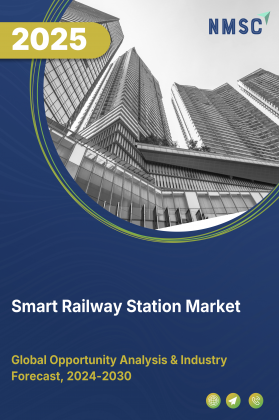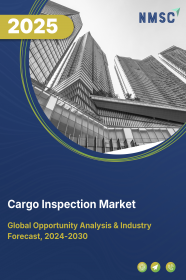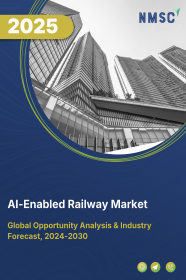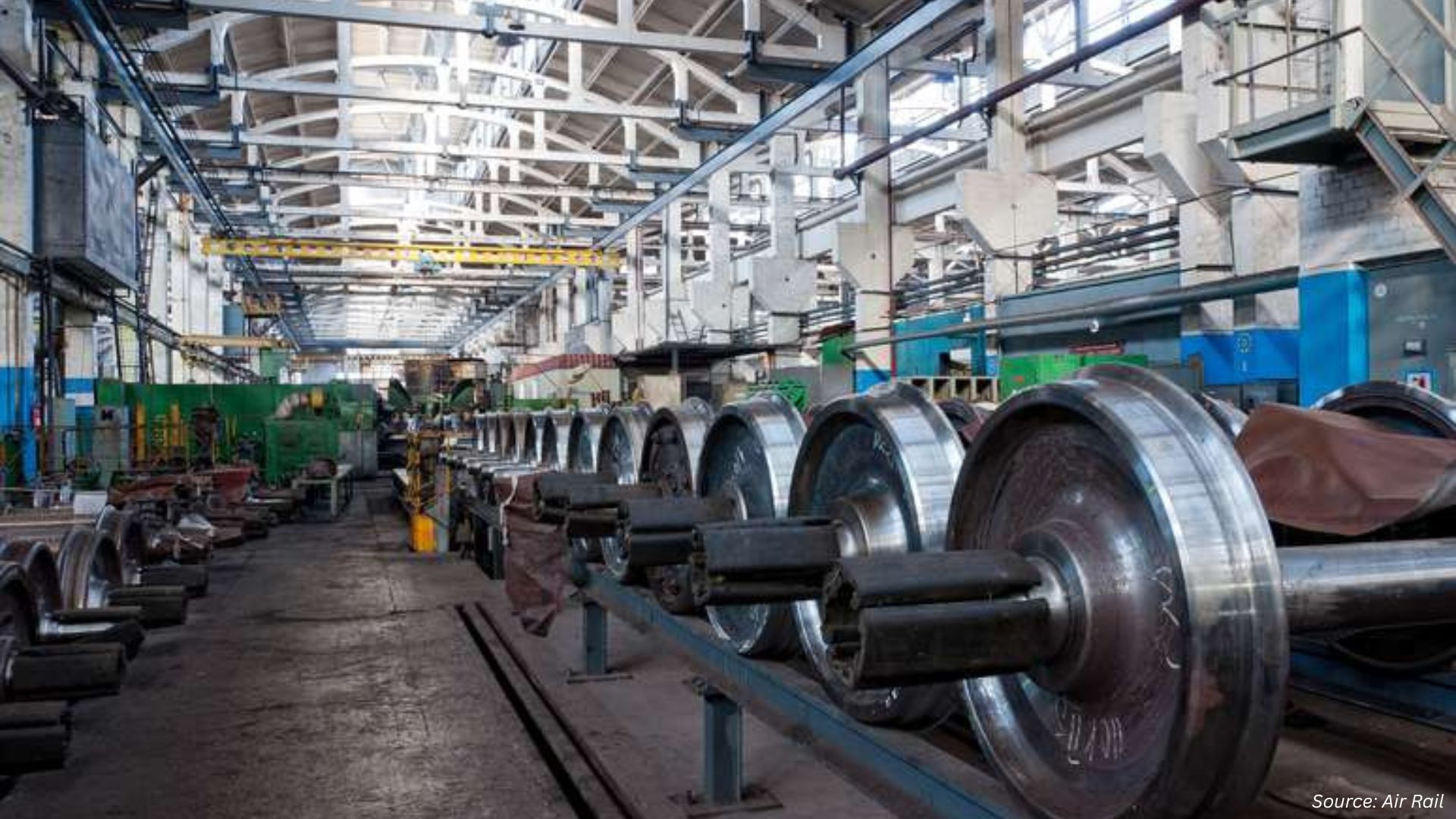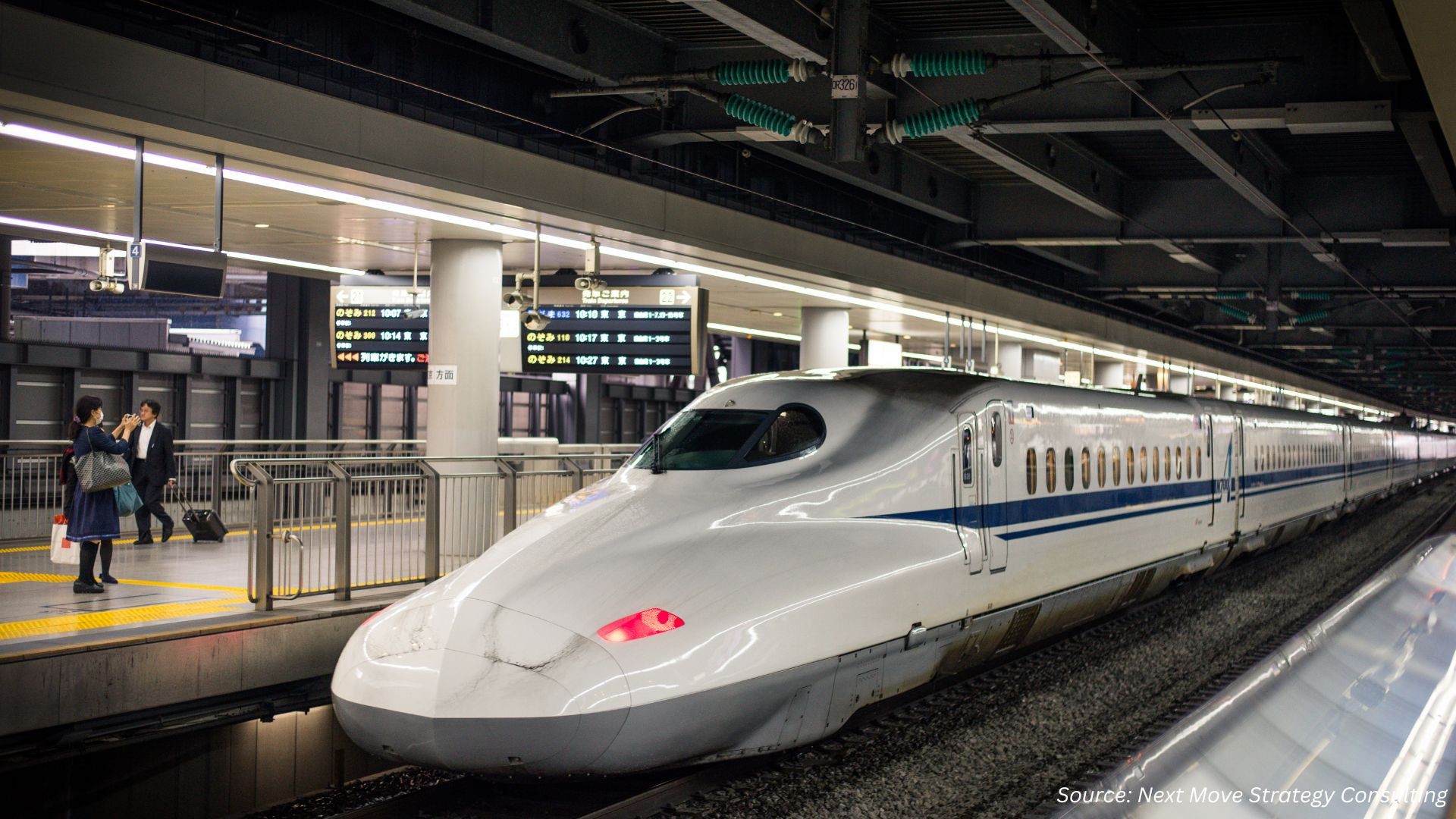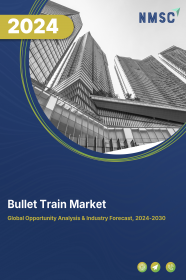
Bullet Train Market by Speed (200-299 km/h, 300-399 km/h, 400-499 km/h, and above 500 km/h), by Technology (Diesel, Electric, and Dual Power), by Component (Axle, Wheelset, Converter, Transformer, Traction Motor, and Others)– Global Opportunity Analysis and Industry Forecast 2024-2030
Market Definition
The global Bullet Train Market size was valued at USD 41.16 billion in 2023 and is predicted to reach USD 64.82 billion by 2030 with a CAGR of 6.7% from 2024-2030. Bullet trains also known as high-speed trains are advanced railway systems designed for rapid transportation. They are characterized by their streamlined design along with high operational speeds and dedicated tracks that allow them to travel at significantly faster speeds than traditional trains.
Bullet trains work by utilizing electric propulsion systems along with their aerodynamic design and specialized tracks to achieve speeds exceeding 500 kilometers per hour. Moreover, these high-speed trains are equipped with advanced speed control systems such as Automatic Train Control (ATC), which involves the transmission of speed information along the train tracks to be received by a signal integrated into the driver's cabin.
These systems play a key role in ensuring the safety and efficiency of these high-speed rail systems. Bullet trains offer several advantages including reduced travel time for passengers, improved connectivity between cities, and lower environmental impact due to reduced carbon emissions which is contrary to the traditional trains.
Market Dynamics and Trends
The growing global population and increasing urbanization are fueling the demand for efficient transportation solutions, in turn boosting the growth of the bullet train market. According to the United Nations, as of November 2022 data, the world population is estimated to reach 9 billion by 2037, with 68% of the global population moving towards urbanization by 2050, creating demand for efficient, fast, and reliable transportation options.
As densely populated cities require rapid and reliable transportation, where bullet trains provide a practical solution, alleviating congestion and ensuring timely travels. This increased demand for efficient transportation in densely populated urban regions, is driving the further growth of the market.
Moreover, the bullet train market is experiencing significant growth due to the concerted efforts of regional market players such as China Railway Rolling Stock Corporation (CRRC), and Saudi Arabia Railways (SAR), in conducting rigorous R&D to advance bullet train technology. It aims to enhance bullet train functionality, reduce carbon emissions, and increase passenger capacity.
For instance, in October 2023, Saudi Arabia Railways (SAR) partnered with Alstom to launch a passenger hydrogen-powered bullet train called the Coradia iLint. This initiative is aimed at reducing carbon emissions in transportation and enhancing passenger transportation services in the Middle East region.
Moreover, in October 2022, China Railway Rolling Stock Corporation (CRRC) developed world's fastest public land transport, the CRRC 600 maglev bullet train with top speed of 600 km/h. The train is designed to carry upto10 carriages, with each holding a capacity of over 100 passengers. This aerotrain, with its high passenger capacity, advanced safety features, and energy-saving technologies is fueling the growth of the market further.
However, the high initial investment required for infrastructure development and technology implementation for building bullet trains is restraining the growth of the market. On the contrary, the introduction of hyperloop technology in the bullet train industry is expected to create lucrative growth opportunities for the market. By integrating Hyperloop, bullet trains can attain increased speeds and efficiency, thereby leading to the potential for substantial growth in the bullet train market.
Market Segmentation and Scope of Study
The bullet train market is divided based on speed, technology, component, and region. Based on speed, the market is categorized into 200-299 km/h, 300-399 km/h, 400-499 km/h, and above 500 km/h. Based on technology, the market is divided into diesel, electric, and dual power.
Based on components, the market is bifurcated into axles, wheelsets, converters, transformers, traction motors, and others. Regional breakdown and analysis of each of the aforesaid segments includes regions such as North America, Europe, Asia-Pacific, and the Rest of the World (RoW).
Geographical Analysis
The Asia-Pacific region holds the dominant share of the bullet train market and is expected to continue its dominance during the forecast period. This is attributed to the surge in business collaborations between developed nations like Japan and Korea and countries seeking high-speed rail solutions, such as India and Indonesia, are boosting the market growth.
These strategic partnerships are fostering long-term profitability and stability, marking a positive trajectory for the bullet train industry in the region. For instance, in July 2023, the Japan International Cooperation Agency (JICA) and the Government of India signed a loan agreement to support the High-Speed Rail project in India. This collaboration focuses on technology transfer from Japan's High-Speed Rail system to India, aligning with the "Make in India" initiative, and fostering international cooperation.
Moreover, increased investment by the government of countries such as China and India, for the development and expansion of railway networks, including high-speed rail systems is boosting the growth of the bullet train market in the region. These investments are driving the construction of new bullet train projects, enhancing city connectivity, and supporting economic growth.
For instance, in February 2023, Indian Railways secured a budget of USD 240 billion in the Union Budget 2023-24. This funding will fuel economic growth and boost demand for efficient rail solutions. The allocation aims to enhance tracks, complete pending projects, and produce high-speed rail facilities, accelerating the adoption of high-speed rail for passengers and freight, and driving market growth.
On the other hand, Europe is expected to show a steady rise in the bullet train market owing to the government initiative to enhance transportation infrastructure, promote eco-friendly travel, and address the increasing demand for fast and convenient modes of transportation.
For instance, in July 2023, Renfe, Spain's state-owned rail network, launched a high-speed AVE service between Barcelona and Lyon, operating daily. This advancement aims to enhance travel convenience, promote tourism, strengthen economic ties, and foster seamless connectivity between the cities, boosting the bullet train industry.
Moreover, increasing collaboration among multiple companies to integrate railway networks across major cities in Europe is driving the growth of the bullet train market in the region. These companies are working together to create seamless, efficient rail networks, these companies meet the rising demand for fast and eco-friendly transportation, ultimately bolstering the bullet train market.
For instance, in April 2022, Eurostar and Thalys two major railway operators from Europe, collaborated under Project Green Speed, to create a rail network covering the U.K., France, the Netherlands, Germany, and Belgium on a single track. The collaboration aims to increase ridership to 30 million a year by 2030 and respond to the growing demand for sustainable travel.
Competitive Landscape
Various market players operating in the bullet train industry are China Railway Rolling Stock Corporation (CRRC) Limited., Bombardier Inc., Alstom SA, Hitachi Ltd., Siemens AG, Kawasaki Rail Car, Inc., ABB Ltd, Construcciones y Auxiliar de Ferrocarriles, S.A., CRRC Corporation Limited, Thales Group, and others. These market players are opting for various strategies such as business expansion and collaboration to maintain their dominance in the global bamboo market.
For Instance, in May 2023, Hitachi and Toshiba secured an order worth USD 1.13 billion under the Hitachi Toshiba Supreme Consortium (HTSC) to construct high-speed trains for Taiwan. These trains will be delivered to Taiwan High-Speed Rail Corporation (THSRC) in 2026.
These are engineered to reach a maximum speed of 320 km/h, and incorporate cutting-edge safety measures and energy-efficient technologies. This order advances Taiwan's transportation infrastructure and encourages the adoption of high-speed rail as a sustainable and efficient mode of travel.
Moreover, in Jan 2023, Siemens signed a USD 3.25 billion contract to supply and service 1,200 electric locomotives for freight transport in India. The locomotives will generate 9,000 horsepower and can pull up to 4,500 metric tons of freight at up to 120 kilometers per hour. The deal is expected to help increase rail freight capacity in a high-speed approach.
Key Benefits
-
The report provides quantitative analysis and estimations of the bullet train market from 2024 to 2030, which assists in identifying the prevailing market opportunities.
-
The study comprises a deep-dive analysis of the current and future bullet train market trends to depict prevalent investment pockets in the market.
-
Information related to key drivers, restraints, and opportunities and their impact on the bullet train market is provided in the report.
-
A competitive analysis of the players, along with their market share is provided in the report.
-
SWOT analysis and Porter's Five Forces model are elaborated in the study.
-
Value chain analysis in the market study provides a clear picture of the roles of stakeholders.
Bullet Train Market Key Segments
By Speed
-
200-299 km/h
-
300-399 km/h
-
400-499 km/h
-
above 500 km/h
By Technology
-
Diesel
-
Electric
-
Dual Power
By Component
-
Axle
-
Wheelset
-
Converter
-
Transformer
-
Traction Motor
-
Others
By Region
-
North America
-
The U.S.
-
Canada
-
Mexico
-
-
Europe
-
The U.K.
-
Germany
-
France
-
Italy
-
Spain
-
Denmark
-
Netherlands
-
Finland
-
Sweden
-
Norway
-
Russia
-
Rest of Europe
-
-
Asia-Pacific
-
China
-
Japan
-
India
-
South Korea
-
Australia
-
Indonesia
-
Singapore
-
Taiwan
-
Thailand
-
Rest of Asia-Pacific
-
-
Rest of the World (RoW)
-
Latin America
-
Middle East
-
Africa
-
REPORT SCOPE AND SEGMENTATION:
|
Parameters |
Details |
|
Market Size in 2023 |
USD 41.16 Billion |
|
Revenue Forecast in 2030 |
USD 64.82 Billion |
|
Growth Rate |
CAGR of 6.7% from 2024 to 2030 |
|
Analysis Period |
2023–2030 |
|
Base Year Considered |
2023 |
|
Forecast Period |
2024–2030 |
|
Market Size Estimation |
Billion (USD) |
|
Growth Factors |
|
|
Countries Covered |
28 |
|
Companies Profiled |
10 |
|
Market Share |
Available for 10 companies |
|
Customization Scope |
Free customization (equivalent to up to 80 working hours of analysts) after purchase. Addition or alteration to country, regional, and segment scope. |
|
Pricing and Purchase Options |
Avail customized purchase options to meet your exact research needs. |
KEY PLAYERS
-
China Railway Rolling Stock Corporation (CRRC) Limited.
-
Bombardier Inc.
-
Alstom SA
-
Hitachi Ltd.
-
Siemens AG
-
Kawasaki Rail Car Inc.
-
ABB Ltd.
-
Construcciones y Auxiliar de Ferrocarriles S.A.
-
CRRC Corporation Limited
-
Thales Group




















 Speak to Our Analyst
Speak to Our Analyst



